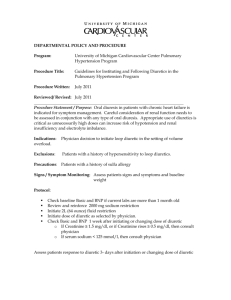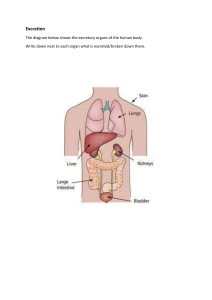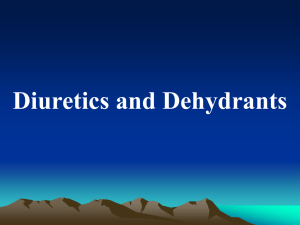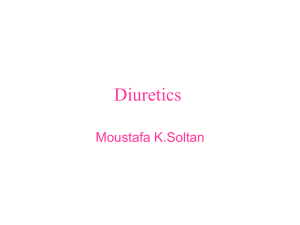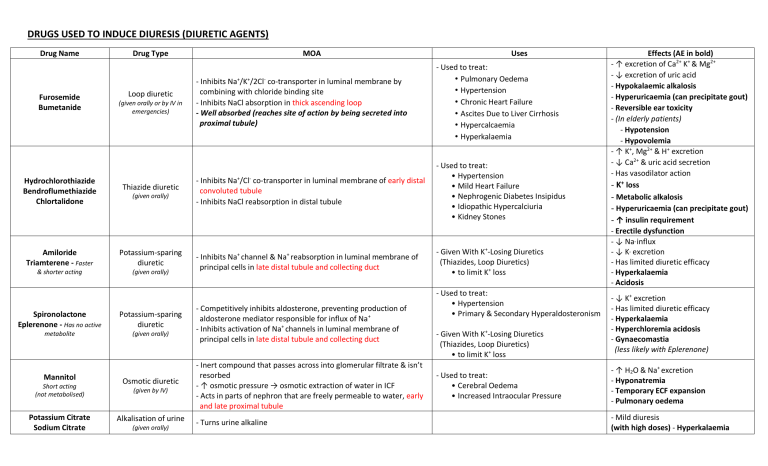
DRUGS USED TO INDUCE DIURESIS (DIURETIC AGENTS) Drug Name Furosemide Bumetanide Hydrochlorothiazide Bendroflumethiazide Chlortalidone Drug Type Loop diuretic (given orally or by IV in emergencies) Thiazide diuretic (given orally) MOA Uses - Inhibits Na+/K+/2Cl- co-transporter in luminal membrane by combining with chloride binding site - Inhibits NaCl absorption in thick ascending loop - Well absorbed (reaches site of action by being secreted into proximal tubule) - Used to treat: • Pulmonary Oedema • Hypertension • Chronic Heart Failure • Ascites Due to Liver Cirrhosis • Hypercalcaemia • Hyperkalaemia - Inhibits Na+/Cl- co-transporter in luminal membrane of early distal convoluted tubule - Inhibits NaCl reabsorption in distal tubule - Used to treat: • Hypertension • Mild Heart Failure • Nephrogenic Diabetes Insipidus • Idiopathic Hypercalciuria • Kidney Stones Effects (AE in bold) - ↑ excretion of Ca2+ K+ & Mg2+ - ↓ excretion of uric acid - Hypokalaemic alkalosis - Hyperuricaemia (can precipitate gout) - Reversible ear toxicity - (In elderly patients) - Hypotension - Hypovolemia - ↑ K+, Mg2+ & H+ excretion - ↓ Ca2+ & uric acid secretion - Has vasodilator action - K+ loss - Metabolic alkalosis - Hyperuricaemia (can precipitate gout) - ↑ insulin requirement - Erectile dysfunction - ↓ Na influx - ↓ K excretion - Has limited diuretic efficacy - Hyperkalaemia - Acidosis + Amiloride Triamterene - Faster Potassium-sparing diuretic & shorter acting (given orally) Spironolactone Eplerenone - Has no active Potassium-sparing diuretic metabolite (given orally) Mannitol Short acting (not metabolised) Potassium Citrate Sodium Citrate Osmotic diuretic (given by IV) Alkalisation of urine (given orally) - Inhibits Na+ channel & Na+ reabsorption in luminal membrane of principal cells in late distal tubule and collecting duct - Competitively inhibits aldosterone, preventing production of aldosterone mediator responsible for influx of Na+ - Inhibits activation of Na+ channels in luminal membrane of principal cells in late distal tubule and collecting duct - Inert compound that passes across into glomerular filtrate & isn’t resorbed - ↑ osmotic pressure → osmotic extraction of water in ICF - Acts in parts of nephron that are freely permeable to water, early and late proximal tubule - Turns urine alkaline + - Given With K -Losing Diuretics (Thiazides, Loop Diuretics) • to limit K+ loss - Used to treat: • Hypertension • Primary & Secondary Hyperaldosteronism - Given With K+-Losing Diuretics (Thiazides, Loop Diuretics) • to limit K+ loss - Used to treat: • Cerebral Oedema • Increased Intraocular Pressure + - ↓ K+ excretion - Has limited diuretic efficacy - Hyperkalaemia - Hyperchloremia acidosis - Gynaecomastia (less likely with Eplerenone) - ↑ H2O & Na+ excretion - Hyponatremia - Temporary ECF expansion - Pulmonary oedema - Mild diuresis (with high doses) - Hyperkalaemia Diuretic Agent Any substance that promotes diuresis (increased production of urine), including forced diuresis Several categories of diuretics, all increase excretion of water from bodies, although each class does so in a distinct way Principals of Diuretic Therapy Diuretics increase urinary flow & water excretion to reduce sodium reabsorption & thus increase urinary sodium This process takes place in different parts of the nephron through inhibition of various transporters, which are mostly in the luminal surface of the tubules Diuretics should be secreted into the tubular fluid & reach the transporters in a sufficient concentration to be useful Main uses: o Treatment of oedema in cases of heart failure, renal failure, nephrotic syndrome & ascites in liver cirrhosis o Treat non oedematous situations, such as hypertension, nephrolithiasis, hypercalcemia & diabetes insipidus

